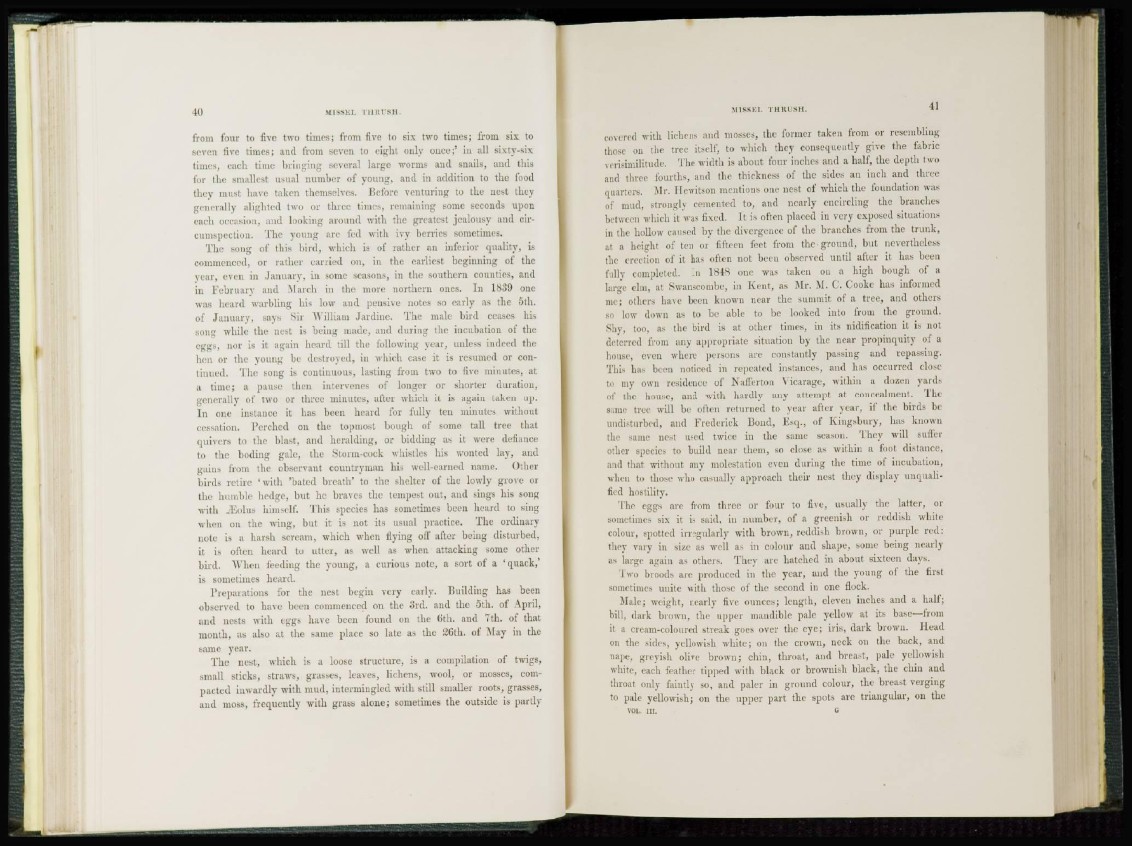
t o ML883 L I ULIT'SH.
from four to five two times; from five to six two times; from six to
seven five times; and from seven to eight only once;' in all sixty-six
times, each time bringing several large worms and snails, and this
for the smallest usual number of young, and in addition to the food
they must have taken themselves. Before venturing to the nest they
generally alighted two or three times, remaining some seconds upon
each occasion, and looking around with the greatest jealousy and circumspection.
'The young arc fed with ivy berries sometimes.
The song of this bird, which is of rather an inferior quality, is
commenced, or rather carried on, in the earliest beginning of the
year, even in January, in some seasons, in the southern counties, and
in February ami March in the more northern ones. In 1839 one
was heard warbling his low and pensive notes so early as the 5th.
of January, says Sir William Jardine. The male bird ceases his
song while the nest is being made, and during the incubation of the
eggs, our is it again heard till the following year, unless indeed the
hen or the young be destroyed, in which case it is resumed or continued.
The song is continuous, lasting from two to five minutes, at
¡1 time; a pause then intervenes of longer or shorter duration,
generally of two or three minutes, after which it is again taken up.
I n one instance it has been heard for fully ten minutes without
cessation. Perched on the topmost bough of some tall tree that
qui\ ers to the blast, ami heralding, or bidding as it were defiance
to the boding gale, the Storm-cock whistles his wonted lay. and
gains from the observant countryman his well-earned name. Other
birds retire 'with 'bated breath' to the shelter of the lowly grove or
the humble hedge, but lie braves the tempest out, and sings his song
with .Kolus himself. This species has sometimes been heard to sing
when on the wing, but it is not its usual practice. The ordinary
note is a harsh scream, which when flying off after being disturbed,
it is often heard to utter, as well as when attacking some other
bird. When feeding the voung, a curious note, a sort of a 'quack,'
is sometimes heard.
Preparations for the nest begin very early. Building has been
observed to have been commenced on the 3rd. and the 5th. of April,
and nests with eggs have been found on the 6th. and 7th. of that
month, as also at the same place so late as the 26th. of May in the
same year.
The nest, which is a loose structure, is a compilation of twigs,
small sticks, straws, grasses, leaves, lichens, wool, or mosses, compacted
inwardly with mud, intermingled with still smaller roots, grasses,
and moss, frequently with grass alone; sometimes the outside is partly
MISSEL THRUSH. •il
covered with lichens and mosses, the former taken from or resembling
those on the tree itself, to which they consequently give the fabric
verisimilitude. The width is about four inches and a half, the depth two
and three fourths, and the thickness of the sides an inch and three
quarters. Mr. Ilcwitson mentions one nest of which the foundation was
of mud, strong!) cemented to, and nearly encircling the branches
between which it was fixed. It is often placed in very exposed situations
in the hollow caused by the divergence of the branches from the trunk,
at a height of ten or fifteen feet from the ground, but nevertheless
the erection of it has often not been observed until after it has been
fully completed. In 184S one was taken on a high bough of a
large elm, at Swanscombc, in Kent, as Mr. M. C. Cooke has informed
mc; others have been known near the summit of a tree, and others
so low down as to be able to be looked into from the ground.
Shy, too, as the bird is at other times, in its nidification it is not
deterred from any appropriate situation by the near propinquity of a
house, even where persons are constantly passing and repassing.
This has been noticed in repeated instances, and has occurred close
to my own residence of Naffer ton Vicarage, within a dozen yards
of the house, and with hardly any attempt at concealment. The
same tree will be often returned to year after year, if the birds be
undisturbed, and Frederick Bond, Esq., of Kingsbury, has known
the same nc.st used twice in the same season. Thev will suffer
other species to build near them, so close as within a foot distance,
and that without any molestation even during the time of incubation,
when to those who casually approach their nest they display unqualified
hostility.
The eggs are from three or four to five, usually the latter, or
sometimes six it is said, in number, of a greenish or reddish white
colour, spotted irregularly with brown, reddish brown, or purple red:
they vary in size as well as in colour and shape, some being nearly
as large again as others. They arc hatched in about sixteen days.
I wo broods are produced in the year, and the young of the first
sometimes unite with those of the second in one flock.
Male: weight, nearly five ounces; length, eleven inches and a half;
bill, dark brown, the upper mandible pale yellow at its base—from
it a cream-coloured streak goes over the eye; iris, dark brown. Head
on the sides, yellowish white; on the crown, neck on the back, and
nape, greyish olive brown; chin, throat, and breast, pale yellowish
white, each feather tipped with black or brownish black, the chin and
throat only faintly so, and paler in ground colour, the breast verging
to pale yellowish; on the upper part the spots are triangular, on the
VOL. in. G